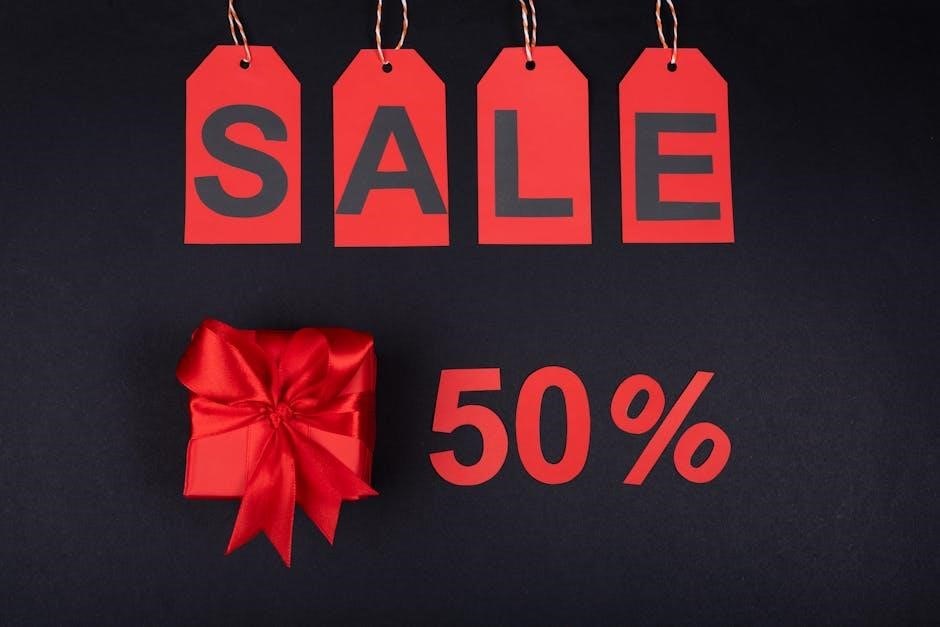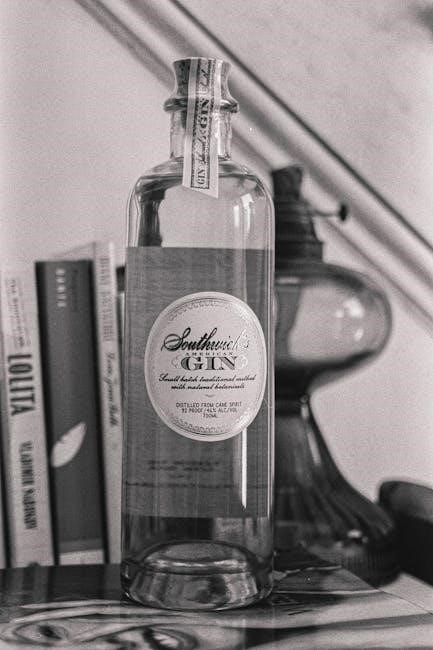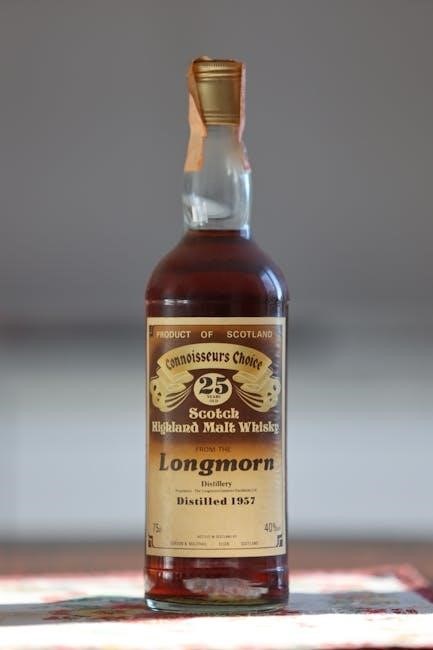Limited Quantity Labels (LQLs) are essential for identifying products with restricted availability, creating urgency in marketing strategies. They are widely used across industries to highlight scarcity and exclusivity, enhancing consumer engagement and driving sales. These labels are customizable, making them versatile tools for branding and promotional campaigns. Their design emphasizes clear communication, ensuring products stand out in competitive markets. LQLs are a key element in modern marketing tactics, combining functionality with aesthetic appeal to capture consumer attention effectively.
Definition and Purpose
A Limited Quantity Label (LQL) is a visual identifier used to denote products or services available in restricted amounts. Its primary purpose is to create a sense of urgency and exclusivity, encouraging consumers to make prompt purchasing decisions. LQLs are widely used in marketing strategies to highlight scarcity, thereby increasing demand and driving sales. These labels are designed to be clear and visually appealing, ensuring they capture consumer attention effectively. By emphasizing limited availability, LQLs help businesses differentiate their offerings and build a competitive edge in the market. They are particularly effective in industries such as retail, cosmetics, and technology, where exclusivity and urgency play a significant role in consumer behavior.
Importance and Benefits
Limited Quantity Labels (LQLs) play a crucial role in driving consumer behavior by creating a sense of urgency and exclusivity. Their importance lies in their ability to motivate immediate action, as consumers are more likely to purchase when they perceive scarcity. This strategy enhances marketing campaigns by highlighting exclusive offers, fostering a competitive edge. The benefits include increased sales, improved customer engagement, and the ability to manage inventory effectively by limiting overstocking. Additionally, LQLs help businesses differentiate their products in saturated markets, making them more appealing to discerning consumers. Their versatility allows customization to fit various branding strategies, ensuring they remain a valuable tool for businesses aiming to boost sales and customer satisfaction. Printable PDF templates further simplify their implementation, making them accessible to businesses of all sizes.

Design Elements of Limited Quantity Labels
Limited Quantity Labels feature bold typography, vibrant colors, and striking graphics to grab attention. They often include countdowns, exclusive offers, or scarcity messaging, ensuring visual appeal and clarity.
Templates and Customization
Printable PDF templates for Limited Quantity Labels offer versatility and ease of customization. Users can modify text, images, and color schemes to align with brand identity. Many templates include placeholders for essential information such as product names, expiration dates, and promotional messages. Design tools like Canva or Adobe Illustrator enable further personalization, allowing businesses to tailor labels to specific campaigns. Customizable elements like QR codes, logos, and graphics enhance functionality and visual appeal. These templates cater to various industries, ensuring adaptability for different products and marketing strategies. By balancing aesthetics with practicality, customizable LQL templates empower businesses to create eye-catching labels that effectively communicate scarcity and exclusivity, driving consumer engagement and sales.
Color Schemes and Readability
Color schemes play a crucial role in the effectiveness of Limited Quantity Labels. High-contrast colors like red, yellow, and black on white backgrounds ensure readability and grab attention instantly. These vibrant combinations are designed to stand out, making it easy for consumers to recognize scarcity and urgency. Clear typography is essential for readability, with bold fonts and sufficient text size to convey messages effectively. Proper spacing between text and graphics avoids clutter, ensuring the label remains visually appealing. The design should balance aesthetics with functionality, ensuring all critical information is easily legible. By using complementary colors and maintaining simplicity, LQLs communicate their intended message clearly, enhancing their impact in marketing and sales strategies.

Legal and Compliance Considerations
Limited Quantity Labels must adhere to local, national, and international regulations to ensure compliance with legal standards. Proper design and content are critical to avoid penalties and ensure validity.
Regulations and Standards
Limited Quantity Labels must comply with specific regulations to ensure legal and safe use. These labels are governed by international standards, such as those set by the International Air Transport Association (IATA) and the U.S. Department of Transportation (DOT). Compliance ensures proper identification of restricted goods and adherence to safety protocols. Regulations dictate the size, color, and content of labels, including mandatory information like hazard symbols and handling instructions. Failure to meet these standards can result in penalties, delays, or legal action. Industries must stay updated on changing regulations to maintain compliance. Proper labeling is critical for safe transportation, storage, and handling of limited quantity items. Adhering to these standards ensures operational efficiency and avoids potential liabilities.
Mandatory Information and Warnings
Mandatory information on Limited Quantity Labels ensures compliance with safety and regulatory requirements. These labels must include clear hazard symbols, handling instructions, and quantity identifiers. The United Nations (UN) number and proper shipping name are essential for identifying the substance. Warnings, such as “Handle with Care” or “Flammable Liquid,” highlight potential risks. Emergency contact details and specific handling precautions are also required. The label must be legible, durable, and prominently displayed. Including these elements ensures safe transportation, storage, and handling of limited quantity items. Compliance with these standards prevents accidents and legal penalties. Proper labeling is critical for protecting people, the environment, and ensuring smooth operational processes. Adherence to these guidelines guarantees that all stakeholders are informed and prepared. Accurate and visible information is vital for safety and efficiency.

Printing Limited Quantity Labels
Printing Limited Quantity Labels requires high-quality materials and precise equipment. Durable paper or vinyl ensures longevity, while vibrant inks maintain visibility. Thermal or laser printers are ideal for crisp text and graphics. Customizable templates allow for tailored designs, meeting specific industry needs. Proper ink adhesion and smudge resistance are crucial for professional results. Regular printer calibration ensures consistent output. Using eco-friendly materials supports sustainability goals. Clear guidelines and standards must be followed to ensure labels are legible and compliant. Investing in reliable printing tools guarantees professional-grade labels. Proper storage of printed labels prevents damage. Attention to detail in printing ensures effectiveness in communication and safety.
Paper and Material Selection
Selecting the right paper and material is crucial for Limited Quantity Labels (LQLs). Durable materials like vinyl or polyester ensure longevity, especially in harsh environments. Water-resistant finishes prevent smudging and fading. Glossy or matte finishes enhance readability and aesthetics. Adhesive strength must match the application surface to avoid peeling. Eco-friendly options, such as recycled paper or biodegradable plastics, cater to sustainability goals. The material choice impacts print quality, durability, and cost. High-grade papers ensure vibrant colors and sharp text, while budget-friendly options suffice for short-term use. Proper material selection balances functionality, appearance, and environmental impact, ensuring labels meet industry standards and user expectations. Always consider the intended use and environmental conditions when choosing materials for LQLs to maximize effectiveness and lifespan. This ensures labels remain legible and professional, fulfilling their purpose successfully.
Printer Types and Ink Requirements
Choosing the right printer and ink is essential for creating high-quality Limited Quantity Labels (LQLs). Thermal printers are ideal for durability, offering smudge-proof and long-lasting prints. Inkjet printers provide vibrant colors and detailed graphics, suitable for eye-catching designs. Laser printers are cost-effective for large-scale printing but may lack the color vibrancy of inkjets. When selecting ink, opt for UV-resistant options to prevent fading. Ensure the printer resolution is high enough to maintain text clarity and image quality. Eco-friendly inks and recyclable materials are increasingly popular for sustainable practices. Match the printer type and ink to your label material for optimal results. Proper alignment of printer and ink ensures professional-grade labels that withstand environmental conditions and maintain their visual appeal over time. Investing in the right equipment guarantees crisp, durable, and visually appealing LQLs.

Usage and Application of Labels
Limited Quantity Labels enhance marketing campaigns by creating urgency and exclusivity. They are widely applied in retail, promotions, and inventory management to streamline operations and boost customer engagement.
Industries That Commonly Use LQLs
Limited Quantity Labels are widely utilized across various industries to create urgency and exclusivity. Retail and e-commerce businesses often use LQLs to promote special offers and clearance sales. Food and beverage companies apply them to highlight seasonal products or limited-edition flavors. Fashion and cosmetics industries employ LQLs to market exclusive collections or last-chance items. Pharmaceutical and healthcare sectors use them for controlled distribution of certain medications. Event ticketing and travel industries also leverage LQLs to promote limited availability, fostering a sense of scarcity. These labels are versatile tools, helping businesses across diverse sectors to drive sales, manage inventory, and enhance customer engagement effectively.
Best Practices for Application
Ensure the surface is clean and dry before applying Limited Quantity Labels for optimal adhesion. Choose labels made from durable, waterproof materials if exposed to harsh conditions. Use alignment tools to position labels precisely, maintaining brand consistency. Apply even pressure to avoid air bubbles and ensure a smooth finish. Include a clear call-to-action, such as a website or QR code, to guide consumer engagement. Regularly inspect labels for wear and tear, replacing them as needed. Print labels with high-quality materials to prevent fading or damage. Avoid overcrowding the design to maintain readability. Always follow industry standards for labeling to ensure compliance and professional appearance. Proper application enhances functionality and visual appeal, making LQLs an effective marketing tool.

Downloading and Editing PDF Templates
Access printable PDF templates for Limited Quantity Labels from reputable sources like TemplateMonster or Canva. Use editing software such as Adobe Acrobat or online tools like Canva to customize text, colors, and images. Ensure proper alignment and spacing for a professional appearance. Add essential details like product name, quantity, and urgency messaging. Test the template with sample data before finalizing. Save in high resolution for crisp printing. Consider adding QR codes or logos for enhanced functionality. Always preview the design to avoid errors. These templates offer flexibility, allowing businesses to create visually appealing labels tailored to their branding needs while maintaining clarity and effectiveness in communication.
Sources for Printable Templates
Printable Limited Quantity Label templates are widely available online, offering convenience and customization. Popular platforms like TemplateMonster, Canva, and Etsy provide professional designs. These websites offer a variety of styles and formats, catering to different branding needs. Additionally, online marketplaces like Graphic River and Creative Market specialize in high-quality, editable templates. Many templates are free or low-cost, making them accessible for businesses of all sizes. Users can download templates in PDF format and customize them using tools like Adobe Acrobat or Canva. These platforms ensure that businesses can create visually appealing and functional labels without extensive design experience. They are ideal for marketing campaigns, product launches, or seasonal promotions, helping businesses stand out in competitive markets. The templates are easy to use, saving time and resources while maintaining professional aesthetics.
Editing Software and Tools
Various software tools are available for editing Limited Quantity Label (LQL) templates in PDF format. Adobe Acrobat is a popular choice, offering advanced features for adding text, images, and shapes. Canva is another user-friendly option, providing drag-and-drop functionality and pre-designed templates. For those on a budget, free tools like Smallpdf or ILovePDF allow basic edits such as text insertion and image placement. Additionally, graphic design tools like Photoshop or Illustrator can be used for more complex customizations. These tools cater to both professionals and non-designers, ensuring scalability and accessibility. They enable users to tailor labels to specific branding needs, enhancing both functionality and visual appeal. By leveraging these tools, businesses can create professional-looking labels that effectively communicate scarcity and exclusivity, driving consumer engagement and sales.

Benefits of Using Limited Quantity Labels
Limited Quantity Labels enhance consumer engagement, drive sales, and create urgency. They are customizable, versatile, and effective for various marketing strategies, making them a valuable tool for businesses.
Creating Urgency and Scarcity
Limited Quantity Labels are a powerful tool for creating urgency and scarcity in marketing campaigns. By clearly indicating that a product is available in limited supply, these labels prompt consumers to act quickly to avoid missing out. Techniques like exclusive offers, countdown timers, and stock level indicators are often integrated into LQL designs to enhance this effect. Customizable templates allow businesses to tailor these labels to specific products or promotions, ensuring they resonate with their target audience. The psychological impact of scarcity can significantly increase the likelihood of a purchase, as consumers are driven by the fear of losing out on a valuable opportunity. This strategy not only boosts sales but also strengthens customer engagement, making it a highly effective marketing tactic.
Enhancing Marketing Strategies
Limited Quantity Labels are a strategic tool for enhancing marketing efforts by making products stand out in competitive markets. These labels create a sense of exclusivity, encouraging consumers to engage more deeply with a brand. By emphasizing scarcity, LQLs can drive impulse purchases and increase customer loyalty. Businesses can customize these labels to align with their branding and promotional campaigns, ensuring consistency and visibility. Additionally, LQLs can be easily integrated into both digital and physical marketing materials, making them versatile for various platforms. Their ability to convey urgency and exclusivity makes them an effective way to capture consumer attention and drive sales. This approach not only enhances marketing strategies but also strengthens the overall brand experience, setting products apart from competitors.
Cost-Effectiveness of LQLs
Limited Quantity Labels are cost-effective, using affordable materials while enhancing marketing impact. They boost sales without significant investment, making them a valuable tool for businesses.
Budget-Friendly Printing Options
Printing Limited Quantity Labels can be done affordably using high-quality materials like vinyl or paper. Digital printing technologies offer cost-effective solutions for small batches. DIY printing with inkjet printers is another budget-friendly option, allowing businesses to create labels in-house. Online platforms provide customizable templates, reducing design costs. Bulk purchasing of labels and ink cartridges further lowers expenses. Eco-friendly materials, such as recycled paper, are both sustainable and economical. Additionally, many printing services offer discounts for large orders, making it feasible for businesses to produce professional-grade labels without overspending. By leveraging these options, companies can maintain brand integrity while staying within budget constraints.
DIY vs. Professional Printing
When deciding between DIY and professional printing for Limited Quantity Labels, consider time, resources, and desired quality. DIY printing offers flexibility and cost savings, ideal for small batches. Home printers can produce labels using downloadable PDF templates, suitable for personal or small business use. However, professional printing ensures high-resolution graphics and durability, perfect for large-scale or high-end products. DIY may lack the precision and materials of professional services, potentially affecting label longevity. For businesses needing consistent, premium labels, professional printing is recommended. Balancing budget and quality, both options have their place depending on specific needs and scale of production. Choose based on your project’s requirements for optimal results.

Case Studies and Real-World Examples
Limited Quantity Labels have proven effective in retail and cosmetics industries, boosting sales through exclusivity. Real-world examples show how LQLs enhance urgency, driving customer engagement and conversions successfully.
Success Stories from Various Industries
Across industries, Limited Quantity Labels (LQLs) have driven significant success. In retail, fashion brands use LQLs to promote exclusive collections, resulting in rapid sell-outs. Cosmetics companies leverage LQLs to create buzz around limited-edition products, enhancing brand loyalty. Similarly, tech firms employ LQLs for product launches, generating excitement and urgency. These examples highlight how LQLs effectively communicate scarcity, influencing consumer behavior and boosting sales. By incorporating customizable designs, businesses tailor LQLs to their brand identity, ensuring a seamless integration into marketing strategies. The versatility of LQLs makes them a valuable tool across diverse sectors, consistently delivering measurable results in competitive markets.
Lessons Learned and Common Mistakes
When implementing Limited Quantity Labels (LQLs), businesses often encounter common pitfalls. One major mistake is using vague or misleading messaging, which can confuse consumers. Additionally, poor readability due to small fonts or low-contrast colors can render labels ineffective. Another error is using incorrect label sizes, which may not fit products properly. Some companies also overlook legal requirements, leading to non-compliance issues. To avoid these mistakes, it’s crucial to test label designs for clarity and readability. Consulting with experts or using pre-designed templates can help ensure compliance and effectiveness. Learning from these common errors can enhance the overall impact of LQLs in marketing and branding strategies.

Customization and Personalization
Customizing Limited Quantity Labels allows businesses to tailor designs to their brand identity, enhancing engagement. Personalization options include logos, colors, and specific text, ensuring labels align with marketing strategies while maintaining functionality and visual appeal.
Branding Opportunities
Limited Quantity Labels offer exceptional branding opportunities, allowing businesses to enhance their brand identity. By incorporating logos, color schemes, and exclusive messaging, companies can create visually appealing labels that resonate with their target audience. These labels not only highlight product scarcity but also reinforce brand recognition, making them a powerful marketing tool. Customizable designs enable businesses to align labels with their overall branding strategy, ensuring consistency across all marketing materials. Additionally, the ability to personalize labels with specific text or imagery provides a unique way to connect with consumers, fostering brand loyalty and engagement. This dual function of functionality and aesthetics makes Limited Quantity Labels a valuable asset for effective brand communication and promotion.
Balancing Aesthetics with Functionality
Striking a balance between aesthetics and functionality is crucial when designing Limited Quantity Labels. Aesthetically pleasing labels attract consumer attention, while functionality ensures clarity and readability. High-quality designs with vibrant colors and clear typography enhance visual appeal without compromising the label’s purpose. Functional aspects such as legibility, durability, and accurate information are equally important to ensure the label serves its intended use. By integrating both elements, labels can effectively communicate the product’s limited availability while maintaining a professional and visually engaging appearance. This balance not only enhances brand image but also ensures the label’s message is conveyed clearly to consumers, making it a vital aspect of label design and application.
Environmental Impact and Sustainability
Limited Quantity Labels can be designed with eco-friendly materials, reducing environmental impact. Using recyclable papers and biodegradable inks supports sustainability efforts, making them a greener choice for businesses aiming to minimize their ecological footprint while maintaining label effectiveness and clarity.
Eco-Friendly Material Options
Eco-friendly materials for limited quantity labels include recyclable papers, biodegradable inks, and non-toxic substances. Kraft paper, bamboo, and sugarcane-based stocks are popular choices, offering durability while minimizing environmental harm. Recycled vinyl options are also available for waterproof applications. These materials ensure labels are sustainable and align with eco-conscious branding. Many manufacturers now provide FSC-certified and compostable alternatives, reducing waste and promoting circular economy practices. Using such materials not only supports environmental conservation but also enhances a company’s commitment to sustainability, appealing to eco-aware consumers. Businesses can choose from a variety of eco-friendly label options to meet their needs while maintaining high-quality printing results and functional performance.
Recycling and Waste Reduction
Recycling and waste reduction are critical in managing limited quantity labels. Many labels are made from recyclable materials like paper and vinyl, which can be repurposed after use. Proper disposal ensures these materials are processed through recycling programs, minimizing landfill waste. Biodegradable labels offer an eco-friendly alternative, breaking down naturally over time. Companies can adopt sustainable practices by designing labels with removable adhesives and using non-toxic inks, making recycling easier. Encouraging consumers to participate in recycling programs further reduces environmental impact. Implementing these strategies not only conserves resources but also aligns with global sustainability goals, promoting a greener future for label production and consumption.

Common Mistakes to Avoid
When creating limited quantity labels, common mistakes include design errors, misinformation, and incorrect material usage. Ensure all details are accurate and comply with regulations. Avoid using low-quality materials that may degrade quickly, and verify that labels are properly sized for their intended use. Incorrect placement or application can lead to visibility issues. Additionally, failing to test labels for durability under various conditions may result in peeling or fading. Always proofread content before printing to avoid typos and ensure clarity. Proper alignment and formatting are crucial for professional appearance. Addressing these issues helps maintain functionality and aesthetic appeal, ensuring labels serve their intended purpose effectively.
Design Errors and Misinformation
Design errors and misinformation are common pitfalls when creating limited quantity labels. One major issue is poor color contrast, making text hard to read. Incorrect font sizes or styles can also reduce readability. Insufficient white space may clutter the label, obscuring key details. Additionally, misinformation, such as wrong quantities or missing symbols, can lead to legal issues. Using outdated templates or incorrect dimensions can result in labels that don’t fit properly. Another mistake is omitting essential information like warnings or batch numbers. Poor image resolution can make graphics appear blurry, undermining professionalism. To avoid these errors, ensure designs are clear, concise, and compliant with industry standards. Always proofread and double-check details before printing to maintain accuracy and effectiveness.
Printing and Application Issues
Printing and application issues can hinder the effectiveness of limited quantity labels. Misalignment during printing may lead to labels being cut incorrectly, rendering them unusable. Incorrect material selection, such as using non-durable paper, can result in labels peeling or fading quickly. Ink smudging or low-quality printers may cause text or graphics to appear blurry, affecting readability. During application, air bubbles or improper alignment can make labels look unprofessional. Additionally, using the wrong adhesive for the surface type may cause labels to detach prematurely. Environmental factors, such as moisture or extreme temperatures, can also damage labels if they are not designed for such conditions. Ensuring proper printer calibration, material compatibility, and careful application is essential to avoid these issues and maintain label integrity. Regular testing and quality checks can help prevent common pitfalls.
